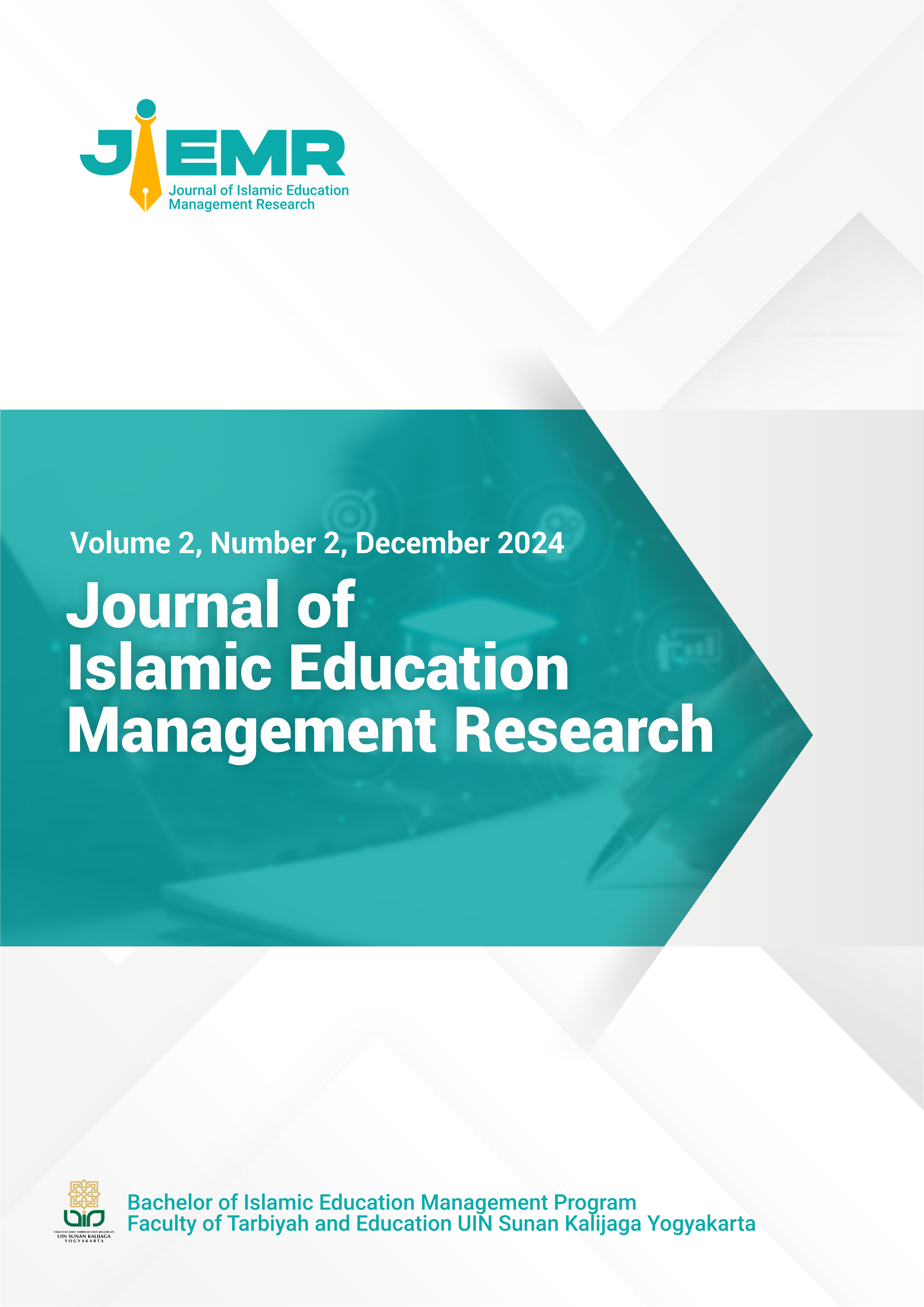Reassessing Strategic Identity: Academic Perceptions of UIN Sunan Kalijaga’s Vision, Mission, and Objectives
DOI:
https://doi.org/10.14421/jiemr.2024.22-06Keywords:
Higher Education Development, Strategic Vision, UIN Sunan KalijagaAbstract
Purpose – This study aimed to assess the perceptions of the academic community regarding the relevance, strengths, and weaknesses of the vision, mission, and objectives of Universitas Islam Negeri (UIN) Sunan Kalijaga Yogyakarta and to propose strategic recommendations for their refinement.
Design/methods – A qualitative research design was employed, utilizing in-depth interviews with selected faculty leaders, literature studies, and document analysis of institutional records to ensure a comprehensive and triangulated understanding. Data were manually coded and thematically analyzed to identify major patterns and critical areas for improvement.
Findings – The findings reveal that UIN Sunan Kalijaga possesses strong institutional pride, iconic status, inclusive and integrative core values, significant academic achievements, and extensive collaborations. However, deficiencies were identified in the clarity, dissemination, and operationalization of its vision and mission, along with a need for greater strategic alignment with contemporary global academic trends.
Research implications/limitations – The purposive sampling method and focus on a limited timeframe may affect the generalizability of the findings. Additionally, the qualitative nature of the study limits the scope for broader quantitative validation across the institution's diverse academic population.
Practical implications – Strengthening participatory governance in updating the vision and mission, enhancing curriculum relevancy, and reinforcing international collaboration mechanisms are critical steps to positioning UIN Sunan Kalijaga as a globally competitive institution.
Originality/value – This research provides one of the first comprehensive qualitative mappings of internal academic perceptions two decades after the formulation of UIN Sunan Kalijaga’s strategic identity, offering empirical recommendations crucial for guiding future institutional development within the global higher education landscape.
Downloads
References
Abbas, S. (2008). Manajemen Perguruan Tinggi. Kencana.
Anisa, C. A., & Rahmatullah, R. (2020). Visi dan Misi Menurut Fred R. David dalam Perspektif Pendidikan Islam. Evaluasi: Jurnal Manajemen Pendidikan Islam, 4(1), 70–87.
Cortés Sánchez, J. D., & Grueso Hinestroza, M. P. (2017). Factor Analysis Evaluation of Schein’s Career Orientations Inventory in Colombia. Business: Theory and Practice, 18(1), 186–196. https://doi.org/10.3846/btp.2017.020
Hladchenko, M. (2016). The Organizational Identity of Ukrainian Universities as Claimed Through Their Mission Statements. Tertiary Education and Management, 22(4), 376–389. https://doi.org/10.1080/13583883.2016.1236144
Kantabutra, S. (2009). Toward a Behavioral Theory of Vision in Organizational Settings. Leadership & Organization Development Journal, 30(4), 319–337. https://doi.org/10.1108/01437730910961667
King, B. (2018). Becoming Iconic. International Journal of Communication, 12, 3390–3408.
Marshall, S. J. (2018). Shaping the University of the Future. Springer Nature Singapore Pte Ltd. https://doi.org/10.1007/978-981-10-7620-6
Middaugh, M. F. (2011). Planning and Assessment in Higher Education: Demonstrating Institutional Effectiveness. John Wiley & Sons. https://www.wiley.com/en-us/Planning+and+Assessment+in+Higher+Education%3A+Demonstrating+Institutional+Effectiveness-p-9780470400906
Mischkind, L. (1998). Pride–The Hidden Corporate Asset. Sirota Consulting.
Ozdem, G. (2011). An Analysis of the Mission and Vision Statements on the Strategic Plans of Higher Education Institutions. Educational Sciences: Theory and Practice, 11(4), 1887–1894.
Paramawardhani, H., Salehudin, A., & Musaffi, N. S. M. (2023). Kalijaga Tracer Study UIN Sunan Kalijaga Yogyakarta 2023. UIN Sunan Kalijaga Yogyakarta dan Cendi. https://digilib.uin-suka.ac.id/id/eprint/63407
Rosyad, A. M., & Maarif, M. A. (2020). Paradigma pendidikan demokrasi dan pendidikan islam dalam menghadapi tantangan globalisasi di indonesia. Nazhruna: Jurnal Pendidikan Islam, 3(1), 75–99.
Royo, J. P. (2017). Students as customers: A paradigm shift in higher education. Debats: Revista de Cultura, Poder i Societat, 2, 137–150.
Ruben, B. D., De Lisi, R., & Gigliotti, R. A. (2023). A guide for leaders in higher education: Concepts, competencies, and tools. Taylor & Francis.
Schaufeli, W. B., & Bakker, A. B. (2004). Job demands, job resources, and their relationship with burnout and engagement: A multi‐sample study. Journal of Organizational Behavior: The International Journal of Industrial, Occupational and Organizational Psychology and Behavior, 25(3), 293–315.
Seeber, M., Barberio, V., Huisman, J., & Mampaey, J. (2019). Factors affecting the content of universities’ mission statements: An analysis of the United Kingdom higher education system. Studies in Higher Education, 44(2), 230–244.
Sopandi, O. D., & Sa’ud, U. S. (2016). Implementasi knowledge management pada perguruan tinggi. Jurnal Administrasi Pendidikan, 13(2).
Suti, M., Syahdi, M. Z., & Didiharyono, D. (2020). Tata Kelola Perguruan Tinggi dalam Era Teknologi Informasi dan Digitalisasi. JEMMA (Journal of Economic, Management and Accounting), 3(2), 203–214.
Tantowi, H. A. (2022). Pendidikan Islam di era transformasi global. PT. Pustaka Rizki Putra.
Whiteley, J., & Whiteley, A. (2006). Core values and organizational change: Theory and practice. World Scientific Publishing Company.
Zamralita, Z. (2017). Gambaran keterikatan kerja pada dosen-tetap ditinjau dari karakteristik personal. Jurnal Muara Ilmu Sosial, Humaniora, Dan Seni, 1(1), 338–345.
Downloads
Published
Issue
Section
License
Copyright (c) 2025 Bermawy Munthe, Ibi Satibi

This work is licensed under a Creative Commons Attribution-NonCommercial-ShareAlike 4.0 International License.
Copyright Notice
Authors who publish with this journal agree to the following terms:
- Authors retain copyright and grant the journal right of first publication with the work simultaneously licensed under a Creative Commons Attribution-ShareAlike 4.0 International License that allows others to copy and redistribute the material in any medium or format with an acknowledgement of the work's authorship and initial publication in this journal and also allows to remix, transform, and build upon the material for any purpose, even commercially with contributions under the same license as the original.
- Authors are able to enter into separate, additional contractual arrangements for the non-exclusive distribution of the journal's published version of the work (e.g., post it to an institutional repository or publish it in a book), with an acknowledgement of its initial publication in this journal.
- Authors are permitted and encouraged to post their work online (e.g., in institutional repositories or on their website) prior to and during the submission process, as it can lead to productive exchanges, as well as earlier and greater citation of published work.









